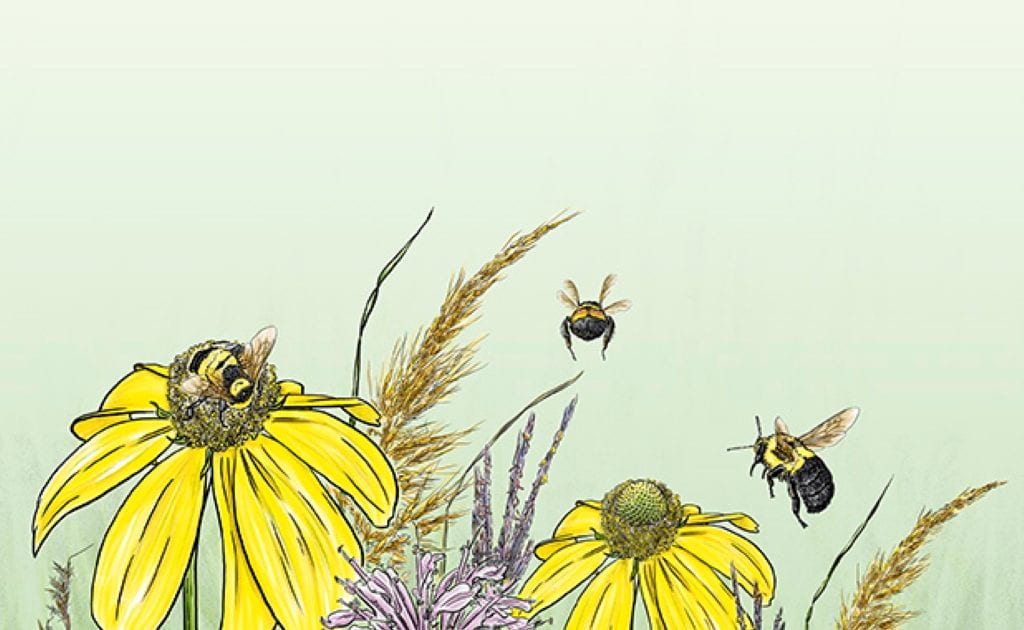By Hayley Brackenridge
Habitat loss and fragmentation are contributing to wild bee population decline across the globe. In Canada, one of the most endangered habitats is tallgrass prairie, which has been reduced to less than 3% of its original range in Southwestern Ontario (Rodger 1998). Tallgrass ecosystems provide habitat for 20% of Ontario’s at-risk species, including several threatened bumble bee species (Colla 2016). Increasing public awareness of tallgrass habitat has promoted restoration and planting efforts; however, the current scale of restoration may not be enough to mitigate predicted climate-induced bee extinctions (Thomas et al. 2004).
The impact of tallgrass prairie ecosystem restoration and management on native bumble bee species is being investigated by University of Guelph graduate student Janean Sharkey. Sharkey is assessing bee abundance, diversity, and community composition in natural and restored tallgrass habitats across Ontario, including sites at rare Charitable Nature Reserve in Cambridge, Ontario. Sharkey’s project is part of Dr. Nigel Raine‘s Food from Thought research program which aims to support conservation strategies for pollinators in a range of habitats, including farms.



Janean Sharkey works at the rare Charitable Research Reserve on the conservation of tallgrass prairies (top left), wild flowers (bottom left), and bumblebees (right). Photo credit: Janean Sharkey.
Sharkey and rare Program Scientist – Research & Education Priorities, Partnerships, & Monitoring, Jenna Quinn, identified that publicly accessible information about bee conservation and tallgrass prairie habitat is minimal. The GIER arts-based knowledge mobilization project was then an excellent opportunity to create very much needed awareness around the research conducted by Sharkey and rare. The team secured the participation of Suzanne Matheson, a natural science illustrator whose work is known for creating beautiful, detailed illustrations that can convey complex ideas and simultaneously inspire and educate.
“I think that’s where the magic happens – when you have people from different fields all thinking about the same problem.”
Janean Sharkey
For this arts-based knowledge mobilization project, the team produced a colouring book highlighting native bee species and their agricultural services and habitats. Each page of the book contains line drawings of bees and their habitats, accurately depicted by Matheson. The trio hopes the colouring book will encourage children and adults to “look closer at the plants, insects, and landscapes around them and appreciate them.”


Conducting field work: Janean Sharkey in photo (left) and as depicted for this arts-based knowledge mobilization piece (right; illustration © Suzanne M. Matheson, 2021).
There is still a need for conservation education and outreach, according to Sharkey, especially regarding native bees and their habitats. She suggests that the colouring book is a step in the right direction, as it mobilizes her research in a way that is easily accessible and enjoyable for people of all ages. Interdisciplinary collaborations, such as this, are effective tools for communicating research to a broader audience. Sharkey says, “[with the help of Quinn and Matheson], I was able to reach an audience that I wouldn’t necessarily have been able to speak to.” Although interdisciplinary research is not foreign to Sharkey, this was her first opportunity to collaborate with someone in fine arts. The experience of working with Quinn and Matheson made Sharkey more open to the value of collaboration opportunities with experts outside the field of science and research. She says, “I think that’s where the magic happens – when you have people from different fields all thinking about the same problem.”


The work conducted by the trio highlights diverse aspects of the life history and ecology of bees: life stages (left) and nesting habits (right). Illustrations © Suzanne M. Matheson, 2021.
The colouring book will be distributed for free at the rare Charitable Research Reserve and used for education purposes by GIER, the University of Guelph, and Food from Thought.



The team: Janean Sharkey (left), Suzanne Matheson (centre), and Jenna Quinn (right).
References:
- Colla, S.R. 2016. Status, threats and conservation recommendations for wild bumble bees (Bombus spp.) in Ontario, Canada: A review for policymakers and practitioners. Natural Areas Journal 26(4):412-426.
- Rodger, L. 1998. Tallgrass Communities of Southern Ontario A Recover Plan. World Wildlife Fund and Ontario Ministry of Natural Resources, Toronto, Ontario. 66pp.
- Thomas, C.D., A. Cameron, R.E. Green, M. Bakkenes, L.J. Beaumont, Y.C. Collingham, B.F.N. Erasmus, M. Ferreira de Siqueira, A. Grainger, L. Hannah, L. Hughes, B. Huntley, A.S. van Jaarsveld, G.F. Midgley, L. Miles, M.A. Ortega-Huerta, A.. Townsend Peterson, O.L. Phillips, and S.E. Williams. 2004. Extinction risk from climate change. Nature 427:145-148.
Banner photo credit: Illustration © Suzanne M. Matheson, 2021 .



